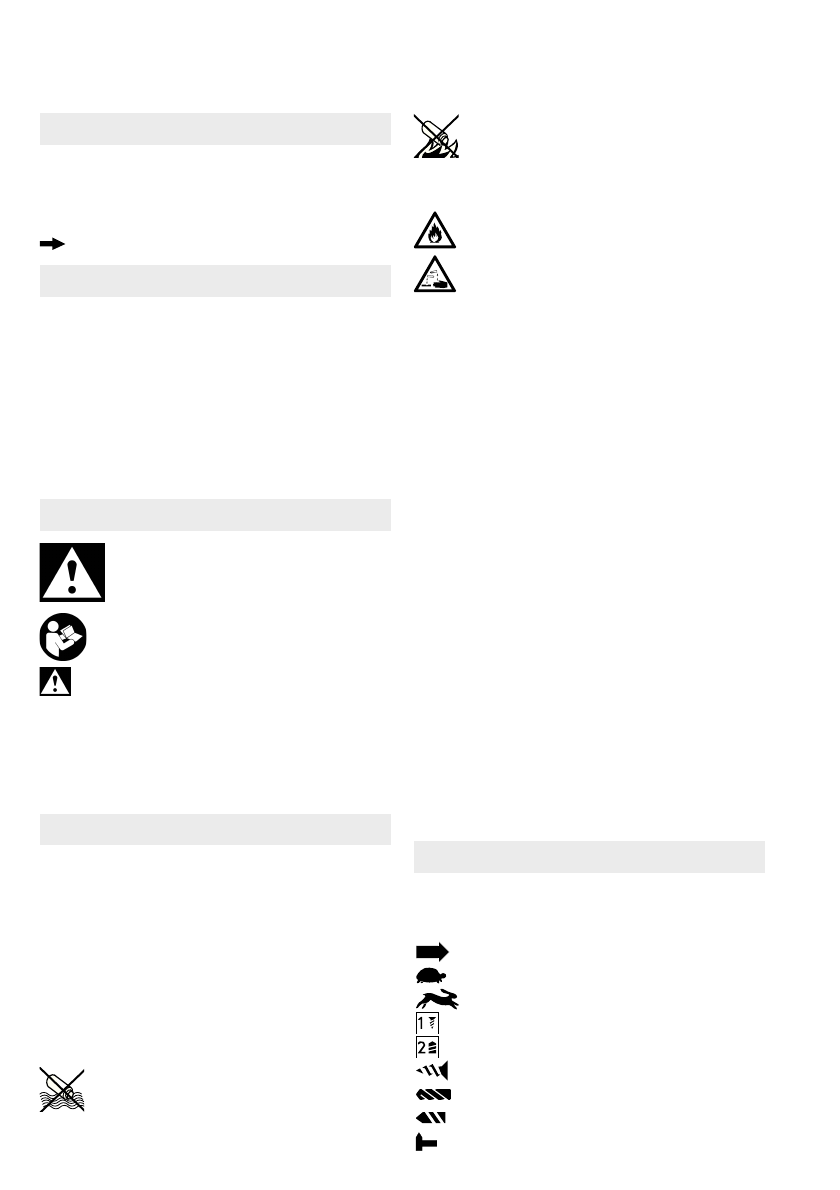Шуруповерты Metabo BS 14.4 Li 602105570 - инструкция пользователя по применению, эксплуатации и установке на русском языке. Мы надеемся, она поможет вам решить возникшие у вас вопросы при эксплуатации техники.
Если остались вопросы, задайте их в комментариях после инструкции.
"Загружаем инструкцию", означает, что нужно подождать пока файл загрузится и можно будет его читать онлайн. Некоторые инструкции очень большие и время их появления зависит от вашей скорости интернета.

ENGLISH
en
9
On our own responsibility, we hereby declare that
these battery-powered drilling screwdrivers and
impact drills, identified by type and serial number
*1), meet all relevant requirements of directives *2)
and standards *3). Technical documents at *4) -
Fig. J
The drills and impact drills are suitable for drilling in
metal, wood, plastic and similar materials, and also
for screwdriving and thread tapping.
The impact drills are also suited for drilling in
masonry, brickwork and stone.
The user bears sole responsibility for any damage
caused by improper use.
Generally accepted accident prevention regula-
tions and the enclosed safety information must be
observed.
For your own protection and for the
protection of your electrical tool, pay
attention to all parts of the text that are
marked with this symbol!
WARNING
– Reading the operating instruc-
tions will reduce the risk of injury.
WARNING Read all safety warnings and
instructions.
Failure to follow all safety warn-
ings and instructions may result in electric shock,
fire and/or serious injury.
Keep all safety instructions and information for
future reference.
Pass on your electrical tool only together with these
documents.
Wear ear protectors with impact drills
(machines with the designation SB).
Exposure
to noise can cause hearing loss.
Hold tool by insulated gripping surfaces, when
performing an operation where the cutting
accessory may contact hidden wiring.
Cutting
accessory contacting a "live" wire may make
exposed metal parts of the electrical tool "live" and
could give the operator an electric shock.
Ensure that the spot where you wish to work is free
of
power cables, gas lines or water pipes
(e.g.
using a metal detector).
Protect battery packs from water and mois-
ture!
Do not expose battery packs to naked flame!
Do not use faulty or deformed battery packs!
Do not open battery packs!
Do not touch or short-circuit battery packs!
Slightly acidic, flammable fluid may leak from
defective li-ion battery packs!
If battery fluid leaks out and comes into
contact with your skin, rinse immediately
with plenty of water. If battery fluid leaks out
and comes into contact with your eyes, wash them
with clean water and seek medical attention imme-
diately.
Remove the battery pack from the machine before
any adjustments, conversions or servicing are
performed.
Before fitting the battery pack, make sure that the
machine is switched off.
Dust from material such as paint containing lead,
some wood species, minerals and metal may be
harmful. Contact with or inhalation of the dust may
cause allergic reactions and/or respiratory diseases
to the operator or bystanders.
Certain kinds of dust are classified as carcinogenic
such as oak and beech dust especially in
conjunction with additives for wood conditioning
(chromate, wood preservative). Material containing
asbestos must only be treated by specialists.
- Where the use of a dust extraction device is
possible it shall be used.
- The work place must be well ventilated.
- The use of a dust mask of filter class P2 is recom-
mended.
Follow national requirements for the materials you
want to work with.
Secure the workpiece against slipping, e.g. with the
help of clamping devices.
LED (9): Do not view LEDs directly through optical
instruments, LED class 1M, classified as per DIN
EN 60825-1: 2003, wavelength: 400-700 nm;
300 µs.
Illustrations are provided at the beginning of the
operating instructions.
Symbol explanation:
Movement direction
Slow
Fast
First gear
Second gear
Screws
Drill bit
Without torque limitation
Impact drilling
Original instructions
1. Declaration of Conformity
2. Specified Use
3. General Safety Instructions
4. Special Safety Instructions
5. Figures





























































